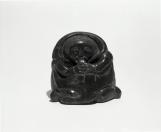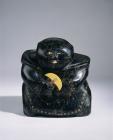1
Eli Weetaluktuk [1910 - 1958]His story
Eli Weetaluktuk began carving after the arrival of James Houston in Inukjuak. He and his two brothers, Sarollie and Simeonie, owned a Peterhead boat, which they used for hunting. In a 2004 interview with Darlene Wight, curator of Inuit art at the Winnipeg Art Gallery, Eli's sister-in-law Lucy describes her husband and his two brothers' seasonal hunting trips: "In the spring they would all go down to the sea to go seal hunting. They would go by dogteam and stay there, and the dogs would go home by themselves. In the late spring and early summer, they would hunt beluga whales. In the summer, they would go fishing. In the winter, it was caribou. The three brothers were always out hunting because they had the right transportation. They were never hungry" (p. 63). Owning a boat meant that Eli was able to work with materials less available to other carvers. "The ability to hunt walruses meant that ivory was available for carving. This is unlike the other camps," wrote Wight in Early Masters (ibid.). His work is included in several private and public collections throughout Canada.
His art
In the interview with Darlene Wight, Lucy recalled that the three brothers worked by using hatchets to break up the stone into smaller pieces, files to create details, and sand to make the stone smooth. They didn't use sandpaper and shoe polish until it became more readily available" (2006:64).
References
Wight, Darlene
2006 Early Masters. Winnipeg: Winnipeg Art Gallery: 63-64.
2
"Woman Skinning Goose" by Eli Weetaluktuk1953
Inukjuak, Quebec, Canada
 Credits:
Credits:Photo: Ernest Mayer
4
"Hunter with Harpoon Line and Knife" by Eli Weetaluktuk1962
Inukjuak, Quebec, Canada
 Credits:
Credits:Photo: York University

